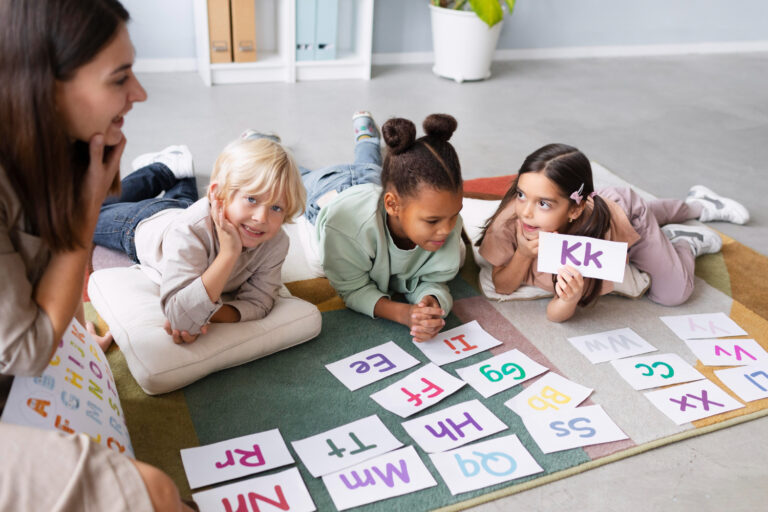Multisensory games to master phonics patterns

Are you looking for ways to make your phonics instruction more fun for students? Consider using manipulatives. The benefit of using manipulatives to master phonics patterns has long been established, especially with struggling readers. Research supports the use of multisensory instructional techniques to engage students, and improve their performance. Teachers can effectively employ multisensory games to help students master phonics patterns.
To ensure that the assessment-to-instruction alignment is clear, it is critical to use lesson plans that include phonics instruction and activities in the appropriate skill areas. To illustrate how this can happen in your classroom, let’s take a look at two imaginary kinder and first grade students.
Keep in mind that the activities introduced below would follow explicit instruction. Activities enable providing practice on skills that have just been taught.
Meet Jose
Jose is a kindergarten student who demonstrates very low scores on DIBELS phonemic awareness measures. His results clearly indicate that he needs PA intervention. The first step is to make sure, through a quick informal assessment, that he knows the lower level of PA (syllable recognition and rhyming). On a phonological awareness continuum he is most likely not ready for segmenting and blending phonemes orally if he cannot isolate and identify the first sounds in words.
The following activities would be ideal to start Jose’s intervention instruction because they emphasize matching initial sounds, the easiest PA activity for most children.
- Initial sound picture card sort (matching): One picture serves as the column header. The teacher hands the student a picture card and the student places the picture under the column with the word that starts with the same first sound.
- Initial Sound Train (matching): Put small objects with two different initial sounds in a paper bag. The student picks one item from the bag, identifies it and decides which of two piles the object belongs, depending on the initial sound.
- Initial Sound Object Sort (matching): Put small objects with two different initial sounds in a paper bag. The student picks one item from the bag, identifies it and decides which of two piles the object belongs, depending on the initial sound.
It is helpful when you introduce this activity to limit these matching activities to closed sorts, so that all of the objects for pictures fit with one of two sounds. Another progression from simple to more challenging is to consider which sounds are paired. It is easiest if the two sounds are very different.
After Jose has mastered matching initial sounds, he will be ready to learn to isolate and identify initial sounds. Once Jose can correctly isolate, identify, and articulate initial sounds, he will learn how to distinguish sounds in the final position in a word. After mastering final sounds, he can move on to identify and articulate middle vowel sounds.
Jose’s progress will be monitored through the use of anecdotal notes, informal assessments, and diagnostic screeners. His teacher will add new activities in the PA lesson plans to help Jose and his classmates learn and master new skills in a specific sequence.
Meet Karen
Karen is a first grader who demonstrates difficulty with letter-sound correspondence. She seems to know most of the uncommon consonants but struggles with reading vowels correctly. Her intervention begins with a brief identification of the consonants she needs help with and a confirmation of whether she knows any short vowels.
Her teacher discovers that Karen needs assistance with all long and short vowels and uses engaging activities during small group to help Karen, and students with similar skill deficits, master these skills.
- Word chains with short vowels sounds: Using magnetic letter tiles or pocket charts with letter cards the students are asked to spell CVC words by selecting from five or six consonants and one vowel. Give them a word chain in which one consonant changes and the vowel is the same. Practice with all five vowels, choosing two vowels at a time. Early on, select vowels that are fairly different in sound, such as i and o.
- Three sound word deck: This is great activity for practicing sound-symbol correspondence and can be used to focus on initial, medial or final word sounds. You’ll need a set of letter and vowel cards. Place the cards face down on the table with the two consonant piles on either side and the vowel pile in the center to make CVC words. The teacher can select the letters that the letters that the students need to practice. The students read the words as the cards are flipped over. Most of the words will be nonsense words which will help improve fluency by making sound-symbol associations and blending sounds together.
Skilled interventionists differentiate what they ask students to do based upon the needs of the child and include engaging phonics games and activities in their daily lesson plans. Documentation is critical during the intervention process so it’s important to collect data while students are completing these activities. Having a variety of kids phonics games to share with your students will improve your phonics instruction.
About 95 Percent Group
95 Percent Group is an education company whose mission is to build on science to empower teachers—supplying the knowledge, resources, and support they need—to develop strong readers. Using an approach that is based in structured literacy, the company’s One95 literacy ecosystem integrates professional learning and evidence-based literacy products into one cohesive system that supports consistent instructional routines across tiers and is proven and trusted to help students close skill gaps and read fluently. 95 Percent Group is also committed to advancing research, best practices, and thought leadership on the science of reading more broadly. For additional information on 95 Percent Group, visit: https://www.95percentgroup.com.



